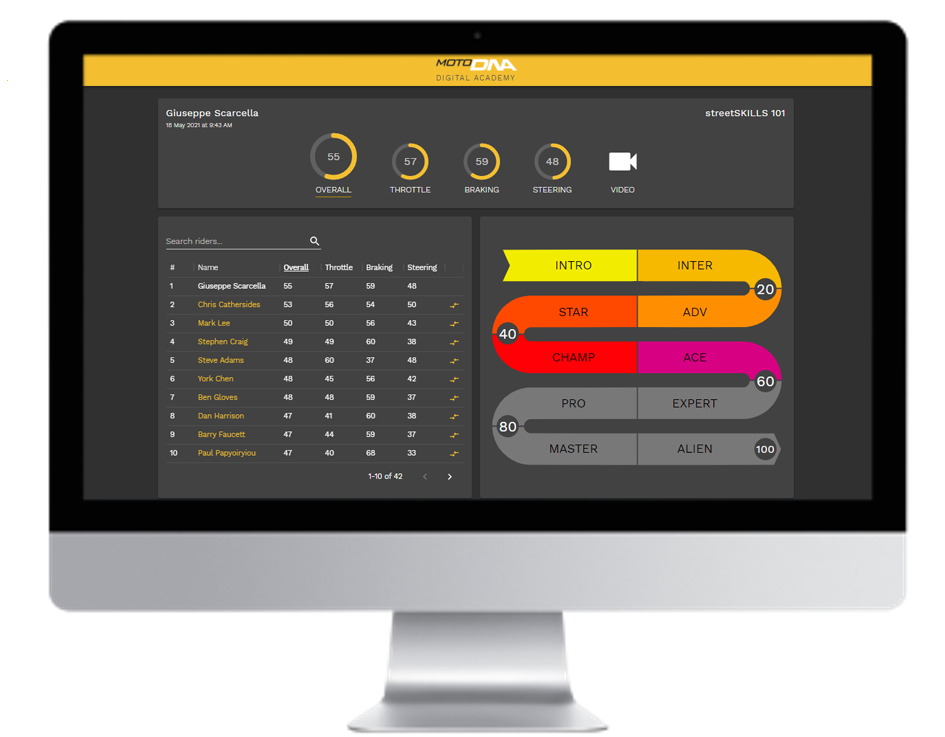ON THE TRACK RACERS
are generally on the throttle or on the brakes – no free wheeling – this wastes time. Trail braking is a technique which racers use to slow the bike as quickly as possible from one speed (on the straight) to another (corner apex speed).
In applying this technique, a racer will approach a turn and at their braking marker apply full braking force, normally with the bike being upright.
As they begin to turn in, they reduce brake pressure, easing off the brakes, decreasing or trailing the brake lever force as the bike lean angle increases until they get to the apex when they release the brake and apply the throttle. Sounds easy enough in theory, but proper execution is complicated because it comes down to feel and remember these guys are doing this seamlessly, every lap and on the limit!
As Freddie Spencer once said, “fast riders have slow hands” so all this is done smoothly, progressively and powerfully.
Also consider a MotoGP machine has so much front tyre grip when upright, that you would easily endo the machine if excessive brake lever force is applied too aggressively, so a certain amount of finesse is required.
Normally only the front brake is used for trail braking as the rear brake contributes little braking power, has less feel and is normally reserved for mid corner fine adjustments or to stabilise the bike.
To comprehend the dynamics of trail braking, ignoring any aerodynamic effects, some understanding of tyres and grip is beneficial, with the amount of grip from the tyres depending on various factors.
The main contributor to grip is the weight or load on each tyre. The ratio of maximum grip and vertical load is called the co-efficient of friction, and this normally decreases relative to the vertical load.
MotoGP tyres go beyond the normal theoretical co-efficient of friction value of 1, hitting values over 1.3. These tyres behave more like Wrigley’s gum, melting into the track surface to create exceptional levels of grip questioning Newton’s model of friction.
Also as the brake is applied, torque is transferred through the wheel to the contact patch which creates a horizontal force at the track surface.
The road pushes back on the tyre and equally the tyre pushes forward on the track surface.
You can thank Newton for this mechanical grip, as for each force there is an equal and opposing force.
Data from Brembo shows deceleration forces over -1.6g are common with riders applying around 8kg of lever pressure at speeds of 350kmh.
For example, at the Sachsenring circuit’s turn 1 during the 2012 MotoGP race the machines where decelerating from over 300kmh to 100kmh in a distance of 253 metres within 5.8 seconds.
As riders spend almost 20% of this lap braking, trail braking is an essential skill to master.
Check out the Monster guys lean angle below while still on the front brake.
Also to consider is the significant grip increase experienced as the front tyre contact patch pressure multiplies due to the load transfer when braking.
This grip effect decreasing as the lean angle increases and the load transfers off the front to the rear.
As the brakes are applied and the weight shifts forward, the forks are also compressed.
This compression of the forks alters the motorcycles steering geometry, reducing the rake and trail. This decreases stability but increases manoeuvrability in a fashion that makes the motorcycle lean and change direction at a higher roll rate.
The tyres temperature also increases from this weight transfer and subsequent tyre loading, with tyre temperature windows critical for optimum grip without tyre degradation.
Another important factor is the reducing road speed which decreases the motorcycle’s cornering radius. Track surface characteristics and other elements between the track and the tyre such as water or oil also play an important part in trail braking efficiency.
Want to learn how to trail brake on the track or road? Book a course with motoDNA
Data Driven
Developed from thousands of riders at the motoDNA Motorcycle Training, our algorithms measure, grade and train motorcycle riders.
Objective
No more guessing, data sensor fusion combined with our algorithms deeply understand rider behaviour.
Towards Zero
Our urgent and ambitious aim is to empower the motorcycle community to take back control towards zero.


